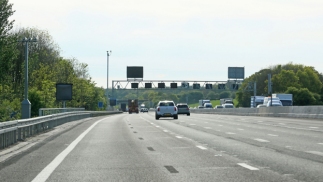Greater
use of a "stealth" speed cameras
Sunday
Times, Driving section feature
Robot spies put police out of a job
A
‘stealth’ camera on the M25 is outstripping traditional speed traps.
150222 More
Speed
cameras explained
A speed camera detector or satnav with a good speed camera
database may be the answer, read more about the different types of detectors
that help keep you on the right side of the law and your licence intact.
Review
of cameras & Hadecs3
Just
how "sneaky" are they?
There has been alarm about new "stealth"
speed cameras. BBC
News 150116
Source:
BBC News 150116 & Sunday Times, Motoring 150222
Posted: 150222
| 
A
set of verification cameras on a pole (far left). In the distance, a single enforcement
camera and radar gun on left side of the gantry (halfway up, visible just above
a square electronic road sign).
Photo credit: BBC News More
| A
new generation of speed cameras is being installed on UK motorways in "significant
numbers" to enforce speed limits - and they are proving very effective. They
are known as Hadecs3 and they are hard to spot as they are a dull grey
colour and require no telltale white markings on the road surface. Without the
yellow painted face seen on traditional Gatso cameras, it's not only their reduced
visibility that causes the "stealth" claims but also the uncertainty
from the variable level of use and enforcement with Hadecs3 by various police
forces on motorways in the UK
Hadecs3
(a sinister name from Highways Agency Digital Enforcement Camera System 3) differs
radically from older systems. A single camera and radar gun are attached to the
gantry or a pole at the side of the road. It can cover all the lanes of a motorway
carriageway. About 200 metres |
away is a set of cameras that takes a wide angle photograph for more detailed
verification - they will take a shot of the speed limit on the gantry signs and
the car.
The new speed camera system was installed in April 2014 between
junctions five and six on the M25 in Kent, near Clacket Lane Services, but it
only became operational in October. By mid January 2015 - less than three months
later - 1,513 people had been caught
by the new cameras of whom 781 had exceeded a speed limit of 70mph, according
to Kent Police. The other 732 had broken a limit of either 40, 50 or 60mph
as the cameras are linked electronically to the signs on overhead gantries displaying
the variable speed limit .
A
recent BBC News report notes "the Highways Agency says the people caught
are a small proportion of the "hundreds of thousands of motorists who use
this stretch of the M25 every day". But without knowing how many motorists
were caught by the old camera systems on a similar stretch of motorway, it's hard
to say whether more drivers are being caught by Hadecs 3".
The
M25 in Kent was chosen for the early installation because it is part of the UK
Government's Smart Motorways policy - where the hard shoulder is used and variable
speed limits enforced. Similar cameras operate on the northern section of the
M25 between junctions 23 and 27. And they will soon be rolled out to other Smart
Motorway sections - the M1 (in Derbyshire and South Yorkshire), M6 (around Birmingham)
and a stretch of the M3.With
concerns over the visibility of the grey Hadecs3 cameras the Highways Agency,
which is part of the Department for Transport, is reported as saying "the
Hadecs3 cameras will be visible and motorists will see the recognisable signs
— a black image of a camera on a white background — that tell them they
are in an area where speed enforcement cameras can operate. The onus is always
on drivers to abide by the speed limit. The cameras have the capability to enforce
the national speed limit but it is up to the police force operating the system
to determine at what level enforcement will be carried out.” That of course
adds to the visibility difficulty by providing another source of uncertainty -
a variable level of use and enforcement with Hadecs on motorways in the UK. |
|



